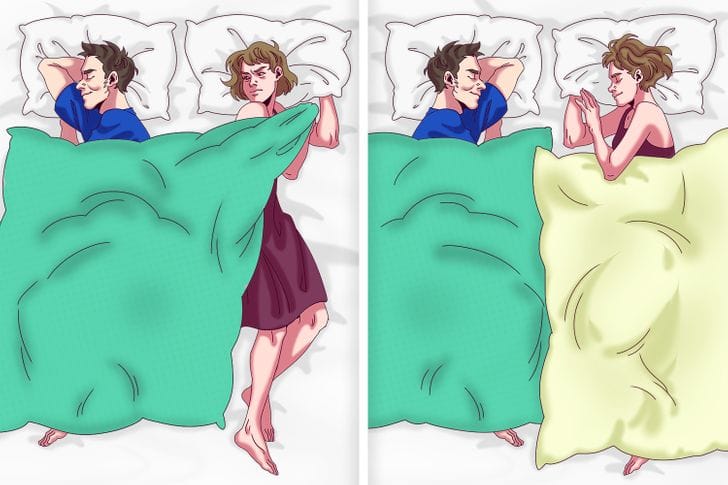Sleeping with another person not only provides us with feelings of safety and security, bonding, and closeness, but it also has considerable health benefits, like lowering levels of cortisol or reducing inflammation. It’s a pleasant addition to the experience, all things considered.Yet some people just seem sleep-incompatible. Opposing sleep cycles, snoring, blanket-hogging, and more are just obstacles that cause low cortisol levels. But let’s not hand over — there are many compromises we will make in terms of bed land.
It always pains us at the silver lining to ascertain relationships get ruined by minor issues. So we gathered some common problems that affect couples at bedtime and need to share them with you.
1. Blanket tug-of-war

Some sleepers are just not into blanket sharing. You attend roll in the hay your relationship being 50/50, but the subsequent thing you recognize, it’s cold, you’re curled in a corner, and shivering. There’s no blanket left for you! It’s futile to undertake to tug it back since the hogging will just happen again. Despite the comical nature of the blanket controversy, it can stiffen your relationship and have a nasty impact on the standard of your sleep.
Solution: a much bigger bed and separate blankets will do the trick! this manner, both of you’ll have your sleeping materials with no need for “stealing” from one another. Ask if your partner is comfortable in the dark — perhaps, they’re freezing, which is why they hog the covers such a lot.
2. Snoring

Imagine you’re snoozing, feeling warm and cozy in your bed, and suddenly, a locomotive’s horn tuts right above your ear. Nope, it’s not an emergency alert, it’s just the one that you love failing to push the air through their nose properly.
As one incident, snoring isn’t an enormous deal, but during a worst-case scenario, it is often a symbol of a much bigger problem. It sabotages bedtime for both parties, leaving the snorer with headaches, weariness, and other evidence of sleep deprivation the subsequent day.
Short-term solution: Change the sleeping position since snoring appears most frequently once we sleep on our backs. Lifting the top may additionally help. attend bed before the snorer and use earplugs. Keep a long way between you, if needed.
Long-term solution: Lifestyle changes, like losing weight, sticking to a sleep schedule, and avoiding alcohol, smoking, and certain medications can help. If the snoring remains happening often, it’s better to ascertain a doctor.
3. Different temperature preferences

66°F to 69°F (19°C to twenty .5°C) is taken into account as n optimal sleeping temperature for many people, but sometimes it can slightly vary. you’ll discover that your partner’s preferable “sleeping settings” differ from yours. With uncomfortable ambient temperature, it takes longer to nod off. It’s harder to urge into a deep sleep also, so you would possibly have trouble staying asleep.
Solution: Get separate bedding to raised fit the requirements of every one of you. It’s difficult to sleep when you’re overheated, so it’s easier for the one that likes to be warmer to compromise. If your partner’s preferable temperature is less than yours, choose more blankets and wear warmer pajamas.
4. Nighttime wake-ups

Unprompted awakening in the middle of the night isn’t uncommon. It is often a symbol of insomnia or the result of stress, electronic use a poor sleep environment, or simply a singular sleep schedule. once you awaken and can’t revisit to sleep after 15 or 20 minutes, there’s no point in only lying here. And if it happens frequently, the primary thing to recollect is to be courteous toward your partner.
Short-term solution: Get out of bed, enter a separate room, and do something calming until you are feeling drowsy again. But don’t do anything while you’re next to your partner. come to the bedroom only you’re able to return to sleep.
Long-term solution: Improve your sleep hygiene. confirm your bedroom is dark, quiet, and fresh. Stop watching screens near bedtime. Don’t eat or drink caffeine before bed. Adopt a soothing nighttime routine and aim for a uniform bedtime.
5. Night sweats

You slipped into a fresh, cool bed and everything seems perfect. But as hours tick on and a couple of people’s bodies heat the environment, many of us start to urge sweaty. Night sweats can quickly become a joint problem if you employ one blanket or cuddle in your sleep. Surely, cuddling or maybe laying on the brink of a sweating person is uncomfortable.
Solution: Sleeping environments and bedding design are the foremost common reasons why people get hot in their sleep. Get yourself a mattress with cooling properties and use breathable clothing and sheets, like airy linen. But night sweats also can be a result of various conditions, and therein case, it’s strongly recommended to go to a doctor to sort things out.
6. Clashing sleep cycles

This is referred to as the first bird vs nighthawk war. We all have our own “chronotype” that reigns over our internal sleep clock. it’s going to change as we get older: young adults peak in “eveningness” and grow to be “morning types” with age.
If you’ve realized that you simply and your partner have an opposing biological time, it’s important to follow your sleep schedule and live consistent with your chronotype. Evening people that attempt to attend bed too early might find themselves with insomnia since the pressure to sleep when the body isn’t ready triggers anxiety and frustration.
Solution: It’s okay to travel to bed at different times. Lighting can help to shift the sle ep schedule slightly. Your body starts to supply a “sle ep hormone,” referred to as melatonin, when it’s dark and stops because it gets lighter, telling us it’s time to awaken. So, bright light exposure in the morning and poor light exposure in the evening may help night owls to maneuver their waking hours a touch.
7. Children in the bed

Sharing a bed with one partner is already a feat on its own, but adding a toddler to the combination can ruin your nighttime rhythm. You’re suddenly awoken, your sle ep is disrupted, and therefore the child crawls into bed, taking over more room. the wedding can become tense due to this, especially if someone has got to leave to form room, and fogeys often feel stuck in situations like this.
Solution: It’s time to toughen up and lead the child back to their bed. They must find out a way to nod off and do so independently. Co-sle eping can have long-term behavioral and cognitive consequences for a toddler, and it can completely ruin sle ep health for folks. and therefore the child is unlikely to grow out of this habit.
What sle eping problems does one or your relations have?
Discover more trends:
- The Top Blow Dryer Brushes of 2024
- WHAT IS A BUTTERFLY HAIRCUT? TIKTOK’S VIRAL HAIRCUT TREND
- Warm and Buttery Hair Color Trends Dominate 2024’s Best Looks
- Follow us on Facebook
- Follow us on Pinterest





